Your Call?
Which is the strongest of today’s five featured flight images? Why did you make your choice?
What’s Up?
This blog post took more than two hours to create.
Today is Saturday 16 September 2023 and I have lots of work to do. Wherever you are an whatever you are doing, I hope that you too have a great day.
Please remember to use the B&H and Amazon links that are found on most blog pages and to use the BIRDSASART discount code at checkout when purchasing your new gear from Bedfords to get 3% back on your credit card and enjoy free second-day air FedEx. Please, also, consider joining a BAA IPT. You will be amazed at how much you will learn!
You can find some great photo accessories (and necessities, like surf booties!) on Amazon by clicking on the Stuff tab on the orange/yellow menu bar above. On a related note, it would be extremely helpful if blog-folks who, like me, spend too much money on Amazon, would get in the habit of clicking on the Amazon logo link on the right side of each blog post when they shop online. As you might expect, doing so will not cost you a single penny, but would be appreciated tremendously by yours truly. And doing so works seamlessly with your Amazon Prime account.
If an item — a Delkin flash card, or a tripod head — for example, that is available from B&H and/or Bedfords, is also available in the BAA Online Store, it would be great, and greatly appreciated, if you would opt to purchase from us. We will match any price. Please remember also to use my B&H affiliate links or to earn 3% cash back at Bedfords by using the BIRDSASART discount code at checkout for your major gear purchases. Doing either often earns you free guides and/or discounts. And always earns my great appreciation.
|
|
|
This image was created on 7 September 2023 on a BIRDS AS ART Instructional Photo-Cruise of a Lifetime at Punta Suárez on Española (Hood) Island in the Galapagos archipelago, Ecuador. I used the hand held Sony FE 400mm f/2.8 GM OSS lens and The One, the Sony Alpha 1 Mirrorless Digital Camera). The exposure was determined via Zebra technology with ISO on the Thumb Dial. ISO 1600. 1/4000 sec. at f/2.8 (wide open) in Manual mode. When evaluated in RawDigger, the raw file brightness was determined to be dead-solid perfect (ho hum). AWB at 7:14:20am on a cloudy morning. Tracking: Zone AF-C with Bird Face/Eye detection enabled performed to perfection. Be sure to click on the image to enjoy a high-res version. Image #1: Waved Albatross on final approach with landing gear down |
Waved Albatross
Due to El Niño, very few pairs of Waved Albatross bred successfully at Punta Suárez on Española (Hood) Island, the world epicenter of this species population. On the first of our two landings at this world class photographic location, we enjoyed perfect flight photography conditions. The soft light was perfect as was my choice of the super-fast Sony 400mm f/2.8 lens. Image #1 of a bird coming in to land is my best ever of this species in flight. Bummer that it opted to land right behind a large bush.
|
|
|
This image was also created on 7 September 2023 on a BIRDS AS ART Instructional Photo-Cruise of a Lifetime at Gardner Bay on Española (Hood) Island in the Galapagos archipelago, Ecuador. I used the hand held Sony FE 400mm f/2.8 GM OSS lens and The One, the Sony Alpha 1 Mirrorless Digital Camera). The exposure was determined via Zebra technology with ISO on the Thumb Dial. ISO 800. 1/3200 sec. at f/2.8 (wide open) in Manual mode. When evaluated in RawDigger, the raw file brightness was determined to be dead-solid perfect (ho hum). AWB at 3:22:30pm on a cloudy-bright afternoon. Tracking: Zone AF-C with Bird Face/Eye detection enabled performed to perfection. Be sure to click on the image to enjoy a high-res version. Image #2: Española (Hood) Mockingbird in flight |
Are You Kidding Me?
Had anyone told me three years ago that I would be able to create sharp images of songbirds in flight with a handheld super telephoto lens, I would have scoffed in disbelief. Yet today, thanks to the Sony A1, creating excellent images of songbirds in flight has become a reality.
Gardner Bay is famed for its flocks of squabbling teenaged mockingbirds. When we landed at Gardner Bay on the afternoon of 7 September, we were greeted by a group of about 20 young mockingbirds duking it out on the clean white sand beach. Anita North made the very best of image of two birds engaged in a midair battle. I will share that one with you here soon.
|
|
|
Click on the image to better see the green eye-AF boxes in action. Sony Alpha 1 Flight Photography AF Points! |
The SONY Alpha a1 Set-up Guide and Info Group: $150.00 (or Free)
The SONY Alpha a1 Set-up Guide and Info Group is going great guns as more and more folks chime in with thoughtful questions and experience-based answers. As the a1 is becoming more readily available, more and more folks are getting their hands on this amazing body. By September 2023, the group was up to an astounding 148 lucky and blessed folks. And more than a few folks own two or more a1 bodies! Early on, we discussed the myriad AF options. I gave my opinion as to the best one for flight and general bird photography. The best news is that everyone in the group receives an e-mail that includes a .DAT file with my a1 settings on it, and explicit directions on how to load my settings onto your a1; talk about convenience! I am now offering a .DAT file compatible with firmware update 1.32. Your entry into the group includes a consolidated Sony a1 CAMSETA2 INFO & GUIDE. New a1 folks will now receive eight e-mails instead of the previous 28! You will receive new e-mails as they are published. Simply put, this e-mail guide is an incredible resource for anyone with an a1.
All who purchased their Alpha 1 bodies via a BAA affiliate link — B&H or Bedfords — will receive a free Sony Alpha a1 Set-Up Guide and free entry into the Info Updates group after shooting me their receipts via e-mail. (Note: it may take me several days to confirm B&H orders.). Others can purchase their guide here in the BAA Online Store.
|
|
|
This image was created on 9 September 2023 on a BIRDS AS ART Instructional Photo-Cruise of a Lifetime at South Plaza Island in the Galapagos archipelago, Ecuador. I used the hand held Sony FE 200-600mm f/5.6-6.3 G OSS lens (at 329mm) and The One, the Sony Alpha 1 Mirrorless digital camera. The exposure was determined via Zebras with ISO on the Thumb Wheel: ISO 1250. RawDigger showed that the exposure, 1/4000 sec. at f/6.3 (wide open), in Manual mode, was perfect. AWB at 2:45:12pm on a cloudy-bright afternoon. Tracking: Zone/AF-C with Bird Eye/Face Detection enabled performed perfectly. Click on the image to enjoy a larger, sharper, high res version. Image #3: Red-billed Tropicbird flying in to cliff nest image
|
Dropping Back to the 200-600
For most cloudy day landings during the first week of the trip, I went with the handheld 400mm f/2.8 lens. As there was lots of great flight photography, my left elbow began to hurt so I switched to the 200-600 lens as it is a lot smaller and a lot lighter than the 400mm f/2.8, albeit quite a lot slower — 2 1/3 stops slower if you are counting. But with my new approach to noise reduction, the higher ISO settings necessitated by the slower f/6.3 aperture have become routinely manageable. Note that in images #3, #4, and #5 that I had zoomed well out from 600mm. As noted in the previous blog post, the 2-6 is incredibly versatile.
|
|
|
This image was created on 9 September 2023 on a BIRDS AS ART Instructional Photo-Cruise of a Lifetime at South Plaza Island in the Galapagos archipelago, Ecuador. I used the hand held Sony FE 200-600mm f/5.6-6.3 G OSS lens (at 368mm) and The One, the Sony Alpha 1 Mirrorless digital camera. The exposure was determined via Zebras with ISO on the Thumb Wheel: ISO 1250. RawDigger showed that the exposure, 1/3200 sec. at f/6.3 (wide open), in Manual mode, was perfect. AWB at 2:47:06pm on a cloudy-bright afternoon. Tracking: Zone/AF-C with Bird Eye/Face Detection enabled performed perfectly. Click on the image to enjoy a larger, sharper, high res version. Image #4: Swallow-tailed Gull dorsal view of juvenile in flight image
|
Dorsal View Flight Images
Most of the time when we are shooting flight we are looking and pointing our lens up at our subjects. When working from tall cliffs, however, we often have a chance to look and point our lens down at the birds. When doing so, we have the opportunity to view the upper surface of the wings, to create images that show a dorsal view. Such images are always different and often superb. Any time that you are above the birds, say when working from a pier of some sort, you many have chances to create top shots. And at times, you may have a chance to create dorsal view flight shots of banking birds.
|
|
|
This image was created on 9 September 2023 on a BIRDS AS ART Instructional Photo-Cruise of a Lifetime at South Plaza Island in the Galapagos archipelago, Ecuador. I used the hand held Sony FE 200-600mm f/5.6-6.3 G OSS lens (at 444mm) and The One, the Sony Alpha 1 Mirrorless digital camera. The exposure was determined via Zebras with ISO on the Thumb Wheel: ISO 2500. RawDigger showed that the exposure, 1/3200 sec. at f/6.3 (wide open), in Manual mode, was perfect. AWB at 4:18:446pm on a then cloudy-getting darker afternoon. Tracking: Zone/AF-C with Bird Eye/Face Detection enabled performed perfectly. Click on the image to enjoy a larger, sharper, high res version. Image #5: Galapagos Shearwater in flight image
|
Maximum Flight Difficulty!
All shearwaters are fast and erratic flyers. The relatively tiny size of Galapagos Shearwater makes them even more difficult to photograph in flight. When my longtime Galapagos guide pointed out some of them uncharacteristically flying above a nearby headland, I alerted nearby group members and then went to work. As even getting a part of these small birds in the frame in focus is a great challenge, I was thrilled with Image #5. You too can learn to become a better flight photographer by ordering a copy of the The Art & Science of Photographing Birds in Flight with the Sony α-1 (even if you do not shoot an α-1.
|
|
|
Click on the composite to view a larger version and be even more impressed. The Art & Science of Photographing Birds in Flight with the Sony α-1
|
The Art & Science of Photographing Birds in Flight with the Sony α-1
by Arash Hazeghi and Arthur Morris
First of all, if you use Nikon or Canon (or Olympus or Fuji) gear, do not be put off by the title. While a portion of the guide deals with the Sony α-1, there is a ton of priceless information, tips, and techniques that can help you become a better flight photographer. No matter what system you are using. If you don not use an α-1, be sure to read down to the bottom to save a few bucks.
Arash Hazeghi and Arthur Morris have created the definitive and most comprehensive ever treatise on photographing birds in flight. With more than sixty years of experience photographing birds, they know what you need to know but have not figured out yet! You will be astounded by the depth of their knowledge and the tips they have to offer. More than six months in the making, the guide contains 229 pages, 24,321 words,97 exceptional and inspirational flight images — each with a legendary, enlightening BIRDS AS ART caption, and 22 screen captures. The guide contains a wealth of useful, practical, and for the most part — never-before-available information.
Purchase
Click here to purchase your copy in the BAA Online Store.
What Everyone Will Learn
We will teach you the basic concepts that you need to master to become a great flight photographer along with the techniques used by the world’s best flight photographers.
You will learn that most any telephoto lens can be perfect for flight photography in a given situation; focal lengths for the images in the book range from 200mm to 1200mm and everywhere in between.
We discuss the merits of various lenses in depth, including and especially comparing the 400mm f/2.8 lenses with the 600mm f/4s.
We guide you in getting your hands on the flight photography lens that will best meet your needs. We offer a variety of handholding and rest position tips and include tips on working with a big lens on a tripod when working with a flight lens that is otherwise too heavy for you.
Both authors offer their thoughts on getting the right exposure when photographing birds in flight. You will learn to get the right exposure on foggy days and even when photographing black birds in white sky conditions.
You will learn the tremendous importance of pre-focusing, of finding the bird in the viewfinder quickly, acquiring focus almost instantly (with tips on doing all three).
You will learn the role of image stabilization in flight photography and the best settings.
Both authors share their thoughts on using the focus range limiter switch. In the same vein, you will learn to use Direct Manual Focus to make your flight photography life easier.
All will learn about the best wing positions and the importance of the background with images of birds in flight. With lots of examples.
You will learn about the best shutter speeds (and the best aperture) to use when photographing flying birds.
You will learn to photograph flight while seated and the many advantages of doing so.
You will learn the best methods of controlling high ISO noise.
All will learn to properly and safely format their flash cards.
You will learn what to do when your AF system is temporarily blinded.
All will learn the huge effect that wind strength and direction has on flight photography and to evaluate the quality and direction of the light on both sunny and cloudy days.
You will learn why it is vitally important to shoot aggressively when photographing birds in flight.
You will learn to carefully observe and evaluate a variety of bird behaviors that may shine light on some excellent opportunities for photographing birds in flight. And about getting into the best position from which to photograph.
You will learn to be a much better flight photographer.
What Sony Folks Will Learn
Exactly how Artie uses Zebras to come up with perfect exposure after perfect exposure.
The fine points and recommended settings for Optical Steady Shot (OSS).
The concept of Auto-Focus (AF) tracking in the α-1.
Everything there is to know about the complex Sony autofocus system.
About all the AF patterns, how to quickly switch them, and about those favored by each author. And why.
The Tracking and Non-tracking AF patterns. When and why Arash uses Non-Tracking Zone. And why Artie uses only two AF patterns.
How to set and use Bird Face-Eye detection for flight photography.
How and why to assign various custom functions to the various programmable buttons on the α-1 body.
The perfect settings for the many, many Menu items that are vitally related to flight photography.
How and why the Sony α-1 uses both contrast and phase detection AF to determine focus (and the benefits thereof).
Which are the best memory cards for the Sony α-1.
To quickly access frequently used menu items.
Non-Sony α-1 Discount
Using the honor system, folks who do not use a Sony α-1 body are invited to click here to save $25.00 on the purchase price of the guide.
Typos
With all blog posts, feel free to e-mail or to leave a comment regarding

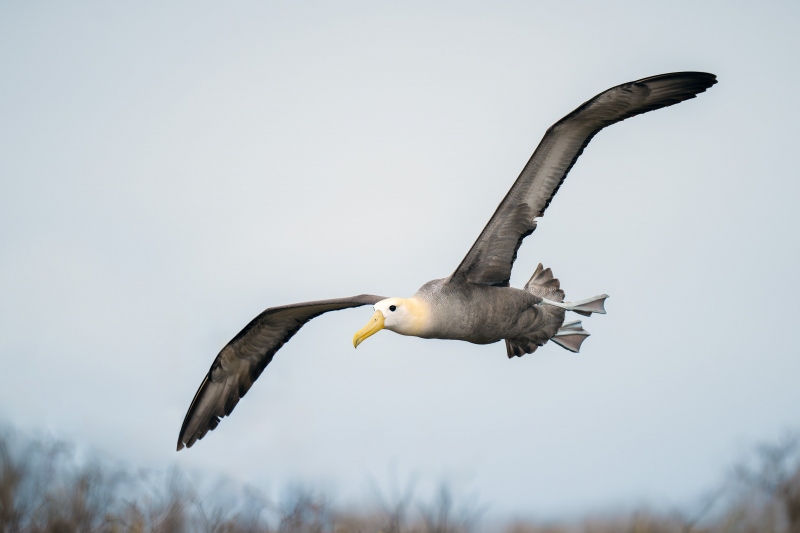
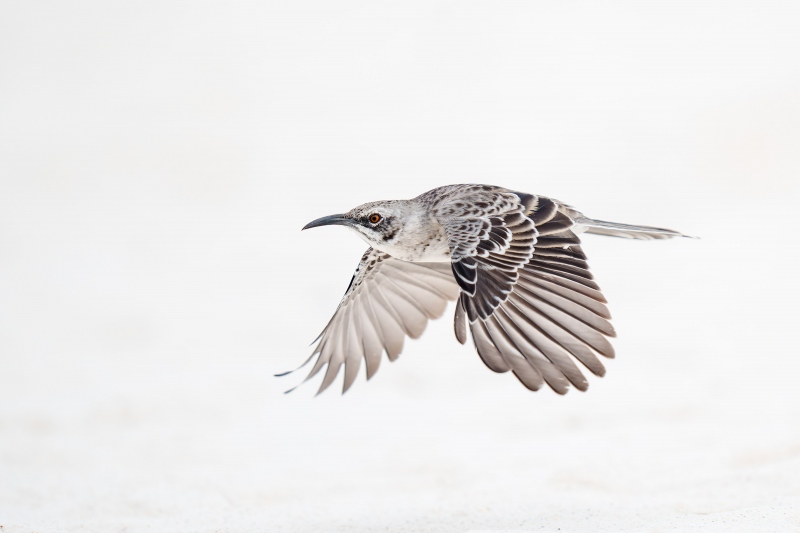
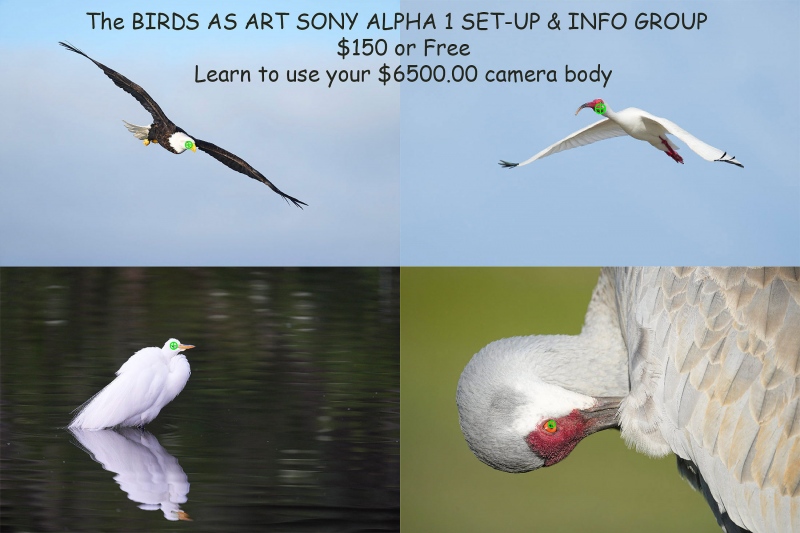
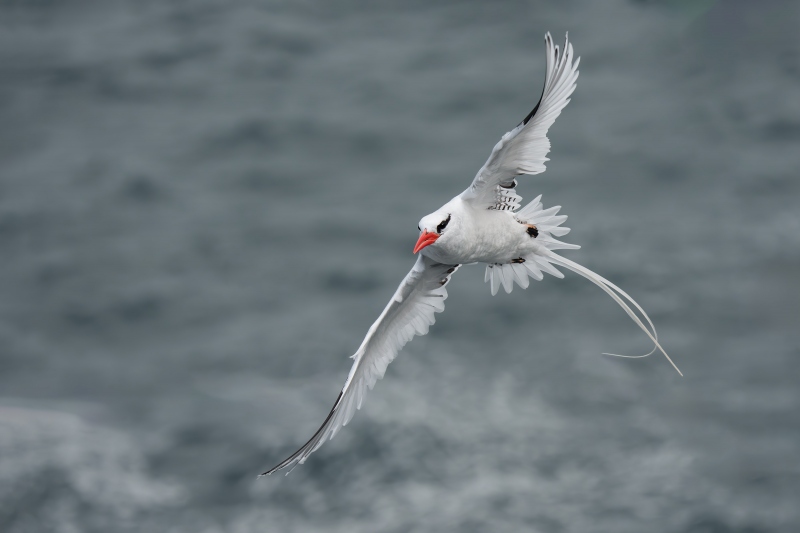
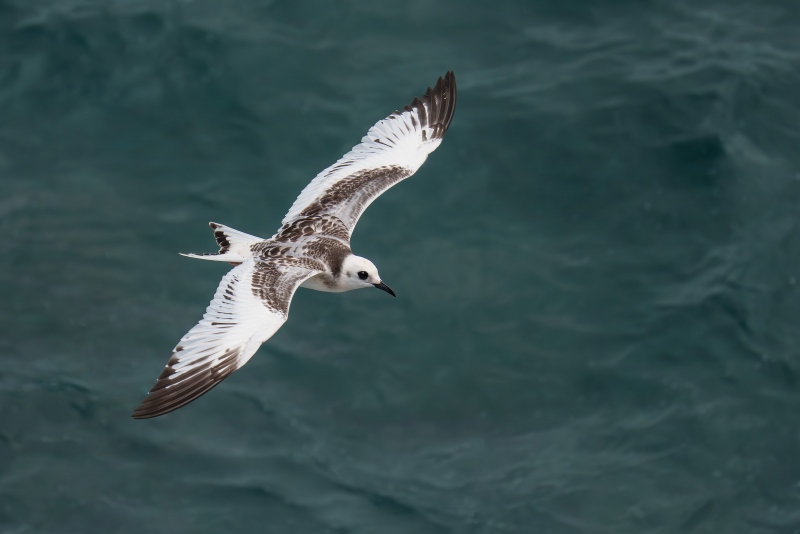
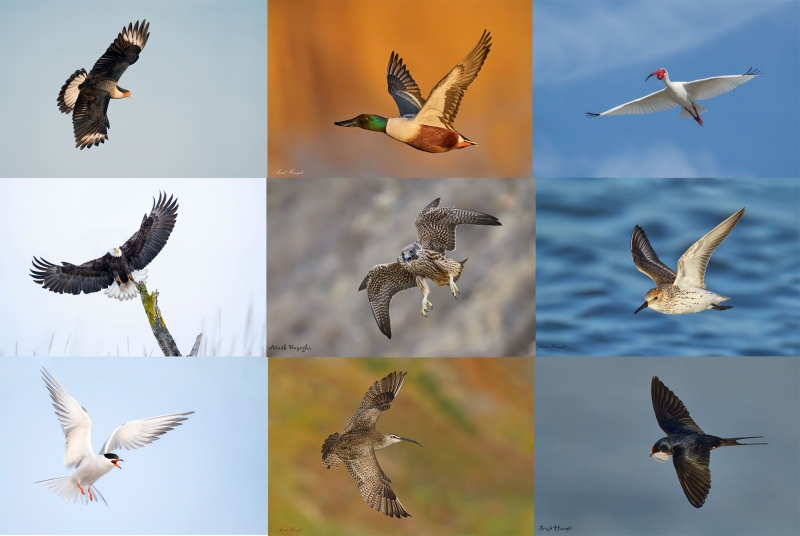













I like #4 best. The dorsal view of juvie plumage, and high contrast between white areas of the subject and the dark sea background make it pop.
My Favourite is #2 but all are good images.
My favorite is #4 because of the dorsal view. Also the coloring and feather pattern is beautiful.
All 5 images are good and well made and good lights!
#3. The Tropicbird has a sense of purpose in moving toward its destination. Plus the orange and black draw my eye.
Tropicbird is my favorite because of the flight angle , bill and tail feather . There is also something powerful about the the background that is a bonus . Mockingbird a close second .
Definitely Mockingbird!
Hi, Artie. I think I agree with Muhammad Arif. I like the orange eye. I was obsessed with the red-billed tropic birds when I was there, and even with the 7DII/EF 100-400L IS II I did get some good flight images.
#2 Mockingbird is my favorite